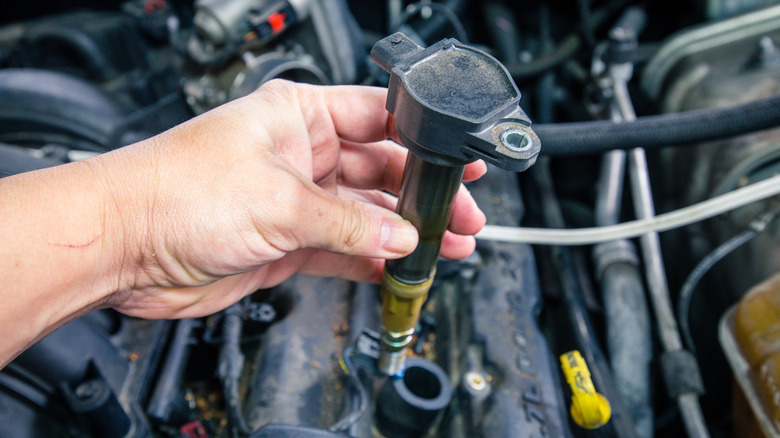
Just like spark plugs, ignition coils can wear down and become faulty over time. There are many common signs that an ignition coil is getting bad, but one obvious sign is an engine misfire, typically felt as a shake or vibration while idle, and a knee-jerk motion when moving.
There are several types of ignition coils, but most vehicles after 1990 come with a coil-on-plug (COP) design. This setup comes with an ignition coil for each spark plug, versus one ignition coil attached to a distributor that activates all of the spark plugs. Although most gas-powered engines only generate 12 volts from the car battery, the ignition coil converts that into at least 20,000 volts before transferring it to the spark plug to ignite the air-fuel mixture.
This is how the spark plug and ignition coil work together to start the car. Since they go hand-in-hand, you should have a mechanic check on your ignition coils when they change your spark plugs, usually around every 80,000 to 100,000 miles. This is especially important because when a failing ignition coil may be unnoticeable at first, but less operating power and lower fuel economy will take a toll on your vehicle before it finally stops working altogether.
 Jorge Villalba/Getty Images
Jorge Villalba/Getty Images
The dreaded check engine light will likely be one of the first signs if your ignition coil is faulty. However, since this indicator can mean multiple things, there are a couple of other things to look out for. Are you having difficulty starting your engine? This could also mean multiple things — such as a dying battery — but if the ignition coil isn't delivering the electricity needed for the spark plug to ignite the air-fuel mixture, then your car isn't going anywhere.
An engine misfire resulting from an incomplete combustion could also occur when the ignition coil is faulty. This is often coupled with a shaking motion, and is probably the most severe symptom of a faulty ignition coil. If you're experiencing this, your car should be taken to a mechanic, pronto. Older cars, which have a traditional ignition coil that runs electricity through a distributor, might even stall. Sadly, it's not an easy fix like jump starting a dead battery. You could also experience backfires, which happens when fuel is detonated in the exhaust. These can cause a lot of damage to the exhaust system.
If you are having any of these issues, don't panic. You technically can drive with a bad ignition coil, but like a flat tire, it's temporary and should get fixed promptly. Luckily, it doesn't cost much. Prepare to pay about $300 for service and parts to replace the ignition coil by a mechanic. If the ignition coils are in an accessible spot, such as on top of the engine, then you can just pay for the parts — likely in the $40 range – and install them yourself.














